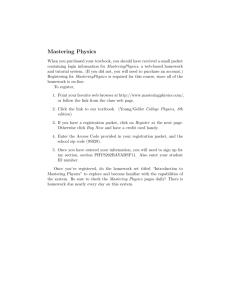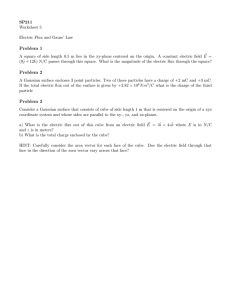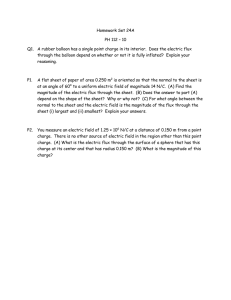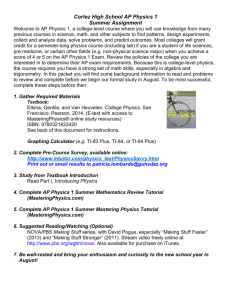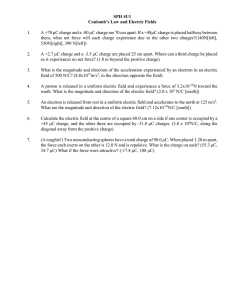Electric Fields & Forces Assignment - Physics 210
advertisement
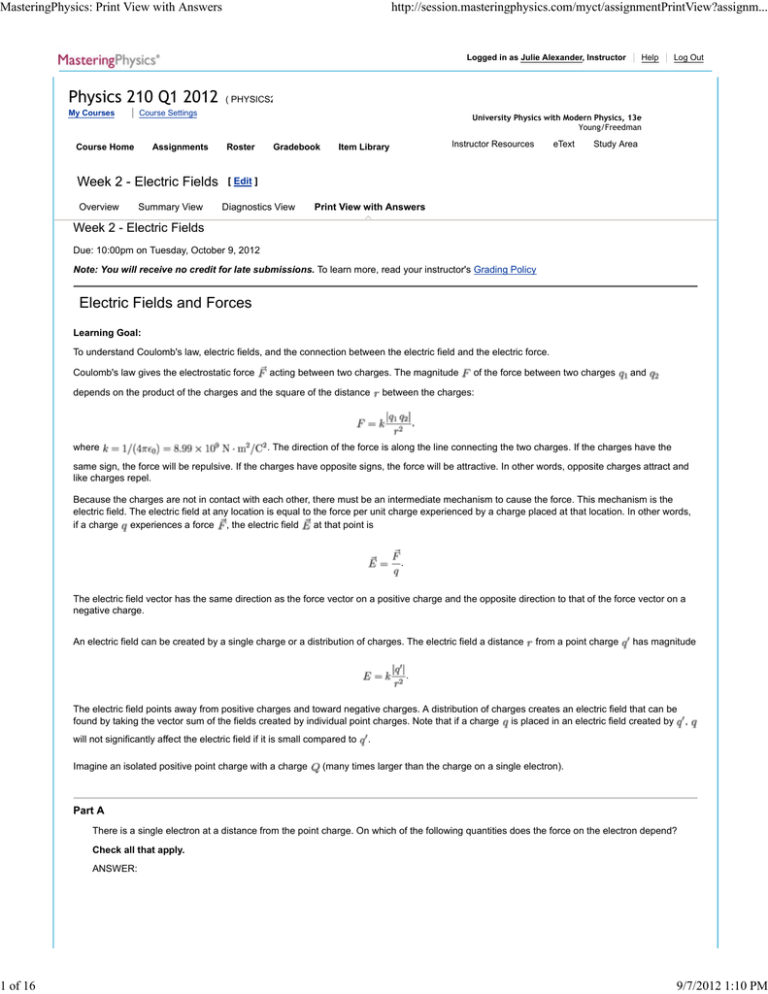
MasteringPhysics: Print View with Answers 1 of 16 http://session.masteringphysics.com/myct/assignmentPrintView?assignm... Help Logged in as Julie Alexander, Instructor Physics 210 Q1 2012 My Courses Assignments Week 2 - Electric Fields Overview ( PHYSICS210BRIDGE ) Course Settings Course Home Summary View Log Out University Physics with Modern Physics, 13e Young/Freedman Roster Gradebook Instructor Resources Item Library eText Study Area [ Edit ] Diagnostics View Print View with Answers Week 2 - Electric Fields Due: 10:00pm on Tuesday, October 9, 2012 Note: You will receive no credit for late submissions. To learn more, read your instructor's Grading Policy Electric Fields and Forces Learning Goal: To understand Coulomb's law, electric fields, and the connection between the electric field and the electric force. Coulomb's law gives the electrostatic force acting between two charges. The magnitude depends on the product of the charges and the square of the distance of the force between two charges and between the charges: , where . The direction of the force is along the line connecting the two charges. If the charges have the same sign, the force will be repulsive. If the charges have opposite signs, the force will be attractive. In other words, opposite charges attract and like charges repel. Because the charges are not in contact with each other, there must be an intermediate mechanism to cause the force. This mechanism is the electric field. The electric field at any location is equal to the force per unit charge experienced by a charge placed at that location. In other words, if a charge experiences a force , the electric field at that point is . The electric field vector has the same direction as the force vector on a positive charge and the opposite direction to that of the force vector on a negative charge. An electric field can be created by a single charge or a distribution of charges. The electric field a distance from a point charge has magnitude . The electric field points away from positive charges and toward negative charges. A distribution of charges creates an electric field that can be found by taking the vector sum of the fields created by individual point charges. Note that if a charge is placed in an electric field created by , will not significantly affect the electric field if it is small compared to Imagine an isolated positive point charge with a charge . (many times larger than the charge on a single electron). Part A There is a single electron at a distance from the point charge. On which of the following quantities does the force on the electron depend? Check all that apply. ANSWER: 9/7/2012 1:10 PM MasteringPhysics: Print View with Answers 2 of 16 http://session.masteringphysics.com/myct/assignmentPrintView?assignm... the distance between the positive charge and the electron the charge on the electron the mass of the electron the charge of the positive charge the mass of the positive charge the radius of the positive charge the radius of the electron According to Coulomb's law, the force between two particles depends on the charge on each of them and the distance between them. Part B For the same situation as in Part A, on which of the following quantities does the electric field at the electron's position depend? Check all that apply. ANSWER: the distance between the positive charge and the electron the charge on the electron the mass of the electron the charge of the positive charge the mass of the positive charge the radius of the positive charge the radius of the electron The electrostatic force cannot exist unless two charges are present. The electric field, on the other hand, can be created by only one charge. The value of the electric field depends only on the charge producing the electric field and the distance from that charge. Part C If the total positive charge is = 1.62×10 −6 , what is the magnitude of the electric field caused by this charge at point P, a distance = 1.53 from the charge? Enter your answer numerically in newtons per coulomb. ANSWER: = = 6220 9/7/2012 1:10 PM MasteringPhysics: Print View with Answers 3 of 16 http://session.masteringphysics.com/myct/assignmentPrintView?assignm... Part D What is the direction of the electric field at point P? Enter the letter of the vector that represents the direction of . ANSWER: Part E Now find the magnitude of the force on an electron placed at point P. Recall that the charge on an electron has magnitude . Enter your answer numerically in newtons. Hint 1. Determine how to approach the problem What strategy can you use to calculate the force between the positive charge and the electron? ANSWER: Use Coulomb's law. Multiply the electric field due to the positive charge by the charge on the electron. Do either of the above. Do neither of the above. ANSWER: = = 9.95×10−16 Part F What is the direction of the force on an electron placed at point P? Enter the letter of the vector that represents the direction of . 9/7/2012 1:10 PM MasteringPhysics: Print View with Answers 4 of 16 http://session.masteringphysics.com/myct/assignmentPrintView?assignm... ANSWER: Electric Field Conceptual Question Part A For the charge distribution provided, indicate the region (A to E) along the horizontal axis where a point exists at which the net electric field is zero. If no such region exists on the horizontal axis choose the last option (nowhere). Hint 1. Zeros of the electric field The net electric field can only be zero if the electric fields due to the two charges point in opposite directions and have equal magnitudes. Therefore, first determine the region(s) where the two constituent electric fields point in opposite directions. Then, in each region determine whether a point exists where the fields have equal magnitude. If there is such a point, then select that region. ANSWER: A B C D E nowhere Part B For the charge distribution provided, indicate the region (A to E) along the horizontal axis where a point exists at which the net electric field is zero. If no such region exists on the horizontal axis choose the last option (nowhere). 9/7/2012 1:10 PM MasteringPhysics: Print View with Answers 5 of 16 http://session.masteringphysics.com/myct/assignmentPrintView?assignm... Hint 1. Zeros of the electric field The net electric field can only be zero if the electric fields due to the two charges point in opposite directions and have equal magnitudes. Therefore, first determine the region(s) where the two constituent electric fields point in opposite directions. Then, in each region determine whether a point exists where the fields have equal magnitude. If there is such a point, then select that region. Hint 2. Determine the regions where the electric fields could cancel In which region(s) do the electric fields from the two source charges point in opposite directions? List all the correct answers in alphabetical order. ANSWER: Since the two charges produce fields that point in opposite directions in these regions, if the magnitude of the fields are equal, the net electric field will be zero. Hint 3. Consider the magnitude of the electric field For each of the three regions found in the previous hint, determine whether it is possible for the magnitudes to be equal. As an example, consider the point directly between the two charges. Which charge produces the largest magnitude field directly between the two charges? ANSWER: the charge on the right the charge on the left neither, because they have the same magnitude Therefore, the point directly between the two charges is not the correct answer since the right charge dominates at this point. Check the other two possible regions. ANSWER: A B C D E nowhere Part C For the charge distribution provided, indicate the region (A to E) along the horizontal axis where a point exists at which the net electric field is zero. If no such region exists on the horizontal axis choose the last option (nowhere). 9/7/2012 1:10 PM MasteringPhysics: Print View with Answers 6 of 16 http://session.masteringphysics.com/myct/assignmentPrintView?assignm... Hint 1. Zeros of the electric field The net electric field can only be zero if the electric fields due to the two charges point in opposite directions and have equal magnitudes. Therefore, first determine the region(s) where the two constituent electric fields point in opposite directions. Then, in each region determine whether a point exists where the fields have equal magnitude. If there is such a point, then select that region. ANSWER: A B C D E nowhere Part D For the charge distribution provided, indicate the region (A to E) along the horizontal axis where a point exists at which the net electric field is zero. Hint 1. Zeros of the electric field The net electric field can only be zero if the electric fields due to the two charges point in opposite directions and have equal magnitudes. Therefore, first determine the region(s) where the two constituent electric fields point in opposite directions. Then, in each region determine whether a point exists where the fields have equal magnitude. If there is such a point, then select that region. ANSWER: 9/7/2012 1:10 PM MasteringPhysics: Print View with Answers 7 of 16 http://session.masteringphysics.com/myct/assignmentPrintView?assignm... A B C D E Nowhere along the finite x axis Exercise 21.54 A straight, nonconducting plastic wire 7.00 long carries a charge density of 130 distributed uniformly along its length. It is lying on a horizontal tabletop. Part A Find the magnitude and direction of the electric field this wire produces at a point 4.00 directly above its midpoint. ANSWER: = 3.85×104 = Part B ANSWER: electric field is directed upward electric field is directed downward Part C If the wire is now bent into a circle lying flat on the table, find the magnitude and direction of the electric field it produces at a point 4.00 directly above its center. ANSWER: = 4.58×104 = Part D ANSWER: electric field is directed upward electric field is directed downward Problem 21.97 Negative charge is distributed uniformly around a quarter-circle of radius that lies in the first quadrant, with the center of curvature at the origin. 9/7/2012 1:10 PM MasteringPhysics: Print View with Answers 8 of 16 http://session.masteringphysics.com/myct/assignmentPrintView?assignm... Part A Find the x-component of the net electric field at the origin. Express your answer in terms of the variables , and appropriate constants. ANSWER: = Also accepted: , Part B Find the y-component of the net electric field at the origin. Express your answer in terms of the variables , and appropriate constants. ANSWER: = Also accepted: , Problem 21.89 - Copy Positive charge is distributed uniformly along the x-axis from , a distance to the right of the end of to . A positive point charge is located on the positive x-axis at . Part A Calculate the x-component of the electric field produced by the charge distribution Express your answer in terms of the variables at points on the positive x-axis where . , , , and and appropriate constants. ANSWER: = Also accepted: , 9/7/2012 1:10 PM MasteringPhysics: Print View with Answers 9 of 16 http://session.masteringphysics.com/myct/assignmentPrintView?assignm... Part B Calculate the y-component of the electric field produced by the charge distribution Express your answer in terms of the variables , , at points on the positive x-axis where . , and appropriate constants. ANSWER: = 0 Part C Calculate the magnitude of the force that the charge distribution Express your answer in terms of the variables exerts on . , , , , and appropriate constants. ANSWER: = Also accepted: , Part D Calculate the direction of the force that the charge distribution exerts on . ANSWER: to the left to the right Problem 21.91 - Copy A charged line extends from y = 2.50 to y = -2.50 . The total charge distributed uniformly along the line is -7.50 . 9/7/2012 1:10 PM MasteringPhysics: Print View with Answers 10 of 16 http://session.masteringphysics.com/myct/assignmentPrintView?assignm... Part A Find the magnitude of the electric field on the -axis at = 10.0 . ANSWER: = = 6550 Part B Find the direction of the electric field on the -axis at = 10.0 . ANSWER: = 180 counterclockwise from the -direction Part C Is the magnitude of the electric field you calculated in part A larger or smaller than the electric field 10.0 from a point charge that has the same total charge as this finite line of charge? ANSWER: larger smaller Part D At what distance does the result for the finite line of charge differ by 1.0% from that for the point charge? Express your answer using two significant figures. ANSWER: = 0.18 Problem 21.100 Two very large parallel sheets are 5.00 right of apart. Sheet , carries a uniform charge of -12.2 carries a uniform surface charge density of -8.00 , and sheet , which is to the . Assume the sheets are large enough to be treated as infinite. Part A Find the magnitude of the net electric field these sheets produce at a point 4.00 to the right of sheet . ANSWER: = = 2.37×105 Part B Find the direction of the net electric field these sheets produce at a point 4.00 to the right of sheet . ANSWER: 9/7/2012 1:10 PM MasteringPhysics: Print View with Answers 11 of 16 http://session.masteringphysics.com/myct/assignmentPrintView?assignm... net electric field is directed to the right net electric field is directed to the left Part C Find the magnitude of the net electric field these sheets produce at a point 4.00 to the left of sheet . ANSWER: = 1.14×106 = Part D Find the direction of the net electric field these sheets produce at a point 4.00 to the left of sheet . ANSWER: net electric field is directed to the right net electric field is directed to the left Part E Find the magnitude of the net electric field these sheets produce at a point 4.00 to the right of sheet . ANSWER: = 1.14×106 = Part F Find the direction of the net electric field these sheets produce at a point 4.00 to the right of sheet . ANSWER: net electric field is directed to the right net electric field is directed to the left Calculating Electric Flux through a Disk Suppose a disk with area makes an angle is placed in a uniform electric field of magnitude . The disk is oriented so that the vector normal to its surface, , with the electric field, as shown in the figure. 9/7/2012 1:10 PM MasteringPhysics: Print View with Answers 12 of 16 http://session.masteringphysics.com/myct/assignmentPrintView?assignm... Part A What is the electric flux through the surface of the disk that is facing right (the normal vector to this surface is shown in the figure)? Assume that the presence of the disk does not interfere with the electric field. Express your answer in terms of , , and Hint 1. Definition of electric flux The electric flux through a surface is given by , where is an infinitesimal element of area on the surface. Hint 2. Simplifying the integrand Note that the formula for electric flux can be expressed in the following way: . Since we are dealing with a constant electric field, which therefore does not vary across the surface of the disk, we can take outside of the integral. This gives a much simpler expression: . Hint 3. Evaluate the scalar product Find in terms of and . ANSWER: = ANSWER: = Flux through a Cube A cube has one corner at the origin and the opposite corner at the point . The sides of the cube are parallel to the coordinate planes. The electric field in and around the cube is given by . Part A Find the total electric flux through the surface of the cube. 9/7/2012 1:10 PM MasteringPhysics: Print View with Answers 13 of 16 http://session.masteringphysics.com/myct/assignmentPrintView?assignm... Express your answer in terms of , , , and . Hint 1. Definition of flux The net electric flux of a field through a closed surface S is given by , where the differential vector has magnitude proportional to the differential area and is oriented outward and normal (perpendicular) to the surface. In some cases with simple geometry (like this one), you can break up the integral into manageable pieces. Consider separately the flux coming out of each of the six faces of the cube, and then add the results to obtain the net flux. Hint 2. Flux through the face Consider the face of the cube whose outward normal points in the positive x direction. What is the flux Express your answer in terms of , , , and through this face? . Hint 1. Simplifying the integral The field depends only on the spatial variable . On the face of the cube, , so is constant. Since is constant over this entire surface, it can be pulled out of the integral: . Hint 2. Evaluate the scalar product The scalar (dot) product yields the component of the field that is in the direction of the normal (i.e., perpendicular to the surface). Evaluate the dot product . Express your answer in terms of , , , , and . ANSWER: = Hint 3. Find the area of the face of the cube This face of the cube is a square with sides of length . What is the area of this face? ANSWER: = ANSWER: = Hint 3. Flux through the face Consider the face of the cube whose outward normal points in the positive y direction. What is the flux Express your answer in terms of , , , and through this face? . ANSWER: 9/7/2012 1:10 PM MasteringPhysics: Print View with Answers 14 of 16 http://session.masteringphysics.com/myct/assignmentPrintView?assignm... = Hint 4. Flux through the face Consider the face of the cube whose outward normal points in the positive z direction. What is the flux through this face? Hint 1. Consider the orientation of the field The electric field has no z component (the field vector xy plane and a vector normal to the lies entirely in the xy plane. What is the dot product of a vector in the face of the cube? ANSWER: = 0 Hint 5. Flux through the face Consider the face of the cube whose outward normal points in the negative x direction. What is the flux Express your answer in terms of , , , and through this face? . Hint 1. What is the electric field? The face of the cube whose outward normal points in the negative x direction lies in the yz plane (i.e., component ). Find the x of the electric field across this surface. ANSWER: = Hint 2. Direction of flux Remember to take note of whether the electric field is going into the surface or out of the surface. Flux is defined as positive when the field is coming out of the surface and negative when the field is going into the surface. ANSWER: = Hint 6. Putting it together Using similar calculations to those above, you should be able to find the flux through each of the six faces. Add the six quantities to obtain the net flux. ANSWER: = Part B Notice that the flux through the cube does not depend on or . Equivalently, if we were to set , so that the electric field becomes 9/7/2012 1:10 PM MasteringPhysics: Print View with Answers 15 of 16 http://session.masteringphysics.com/myct/assignmentPrintView?assignm... , then the flux through the cube would be zero. Why? ANSWER: does not generate any flux across any of the surfaces. The flux into one side of the cube is exactly canceled by the flux out of the opposite side. Both of the above statements are true. Part C What is the net charge inside the cube? Express your answer in terms of , , , , and . Hint 1. Gauss's law Gauss's law states that the net flux of an electric field through a surface is proportional to the net charge inside that surface: . ANSWER: = Exercise 22.10 A point charge = 3.15 is located on the x-axis at = 2.25 , and a second point charge = -5.65 is on the y-axis at = 1.05 . Part A What is the total electric flux due to these two point charges through a spherical surface centered at the origin and with radius = 0.440 ? ANSWER: = 0 Part B What is the total electric flux due to these two point charges through a spherical surface centered at the origin and with radius = 1.70 ? = 2.95 ? ANSWER: = = -638 Part C What is the total electric flux due to these two point charges through a spherical surface centered at the origin and with radius ANSWER: = = -282 9/7/2012 1:10 PM MasteringPhysics: Print View with Answers 16 of 16 http://session.masteringphysics.com/myct/assignmentPrintView?assignm... Copyright © 2012 Pearson. All rights reserved. Legal Notice Privacy Policy Permissions Support 9/7/2012 1:10 PM

